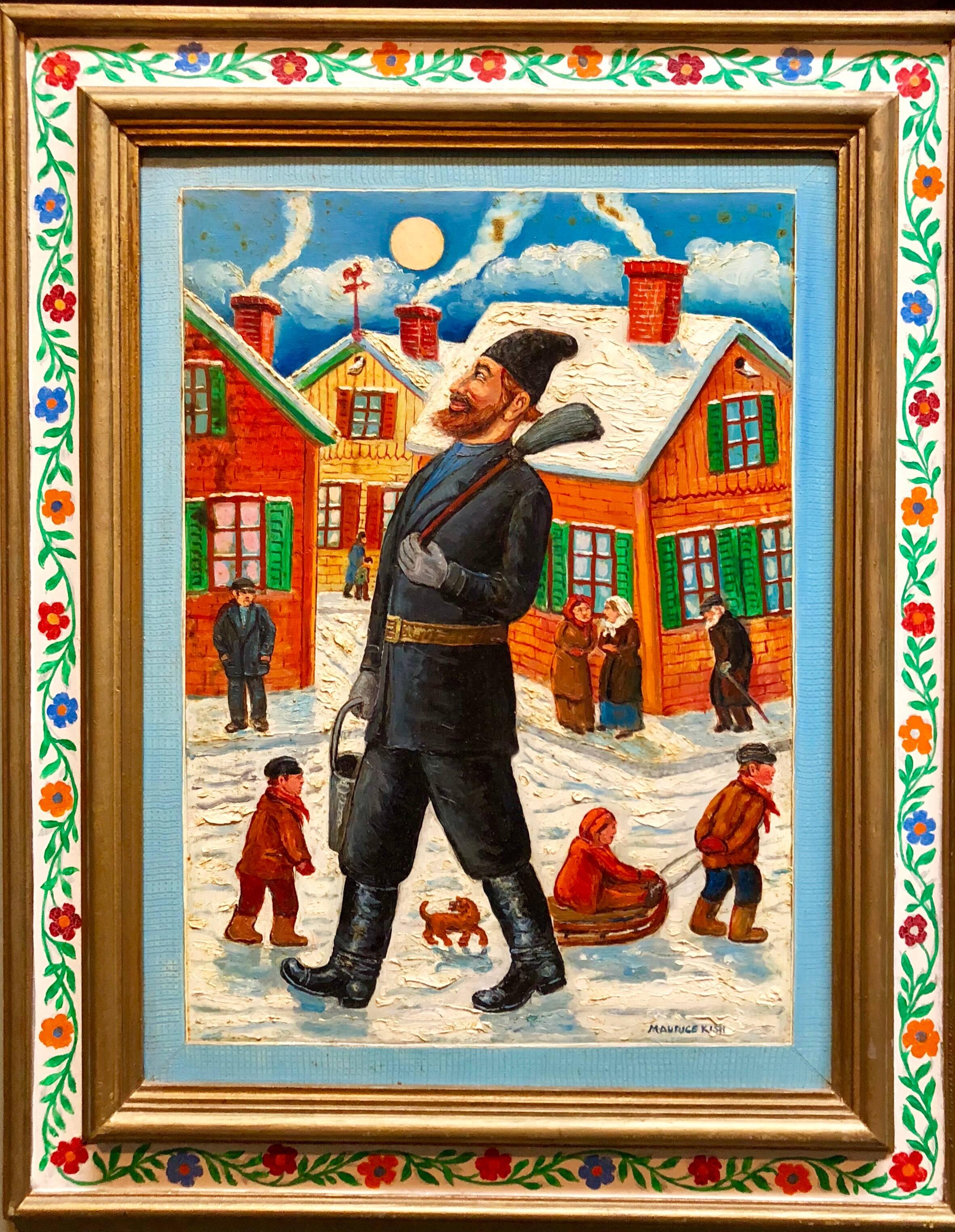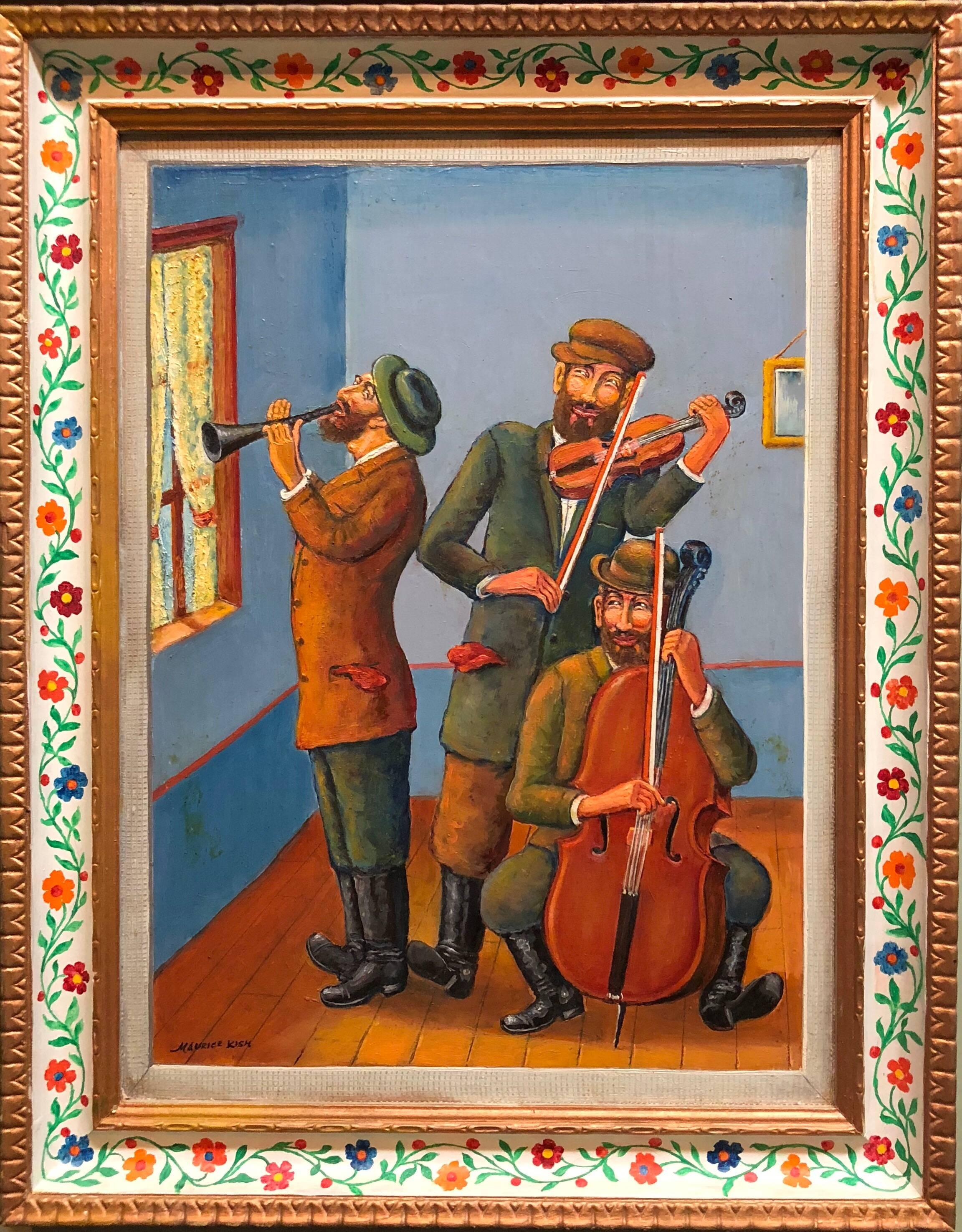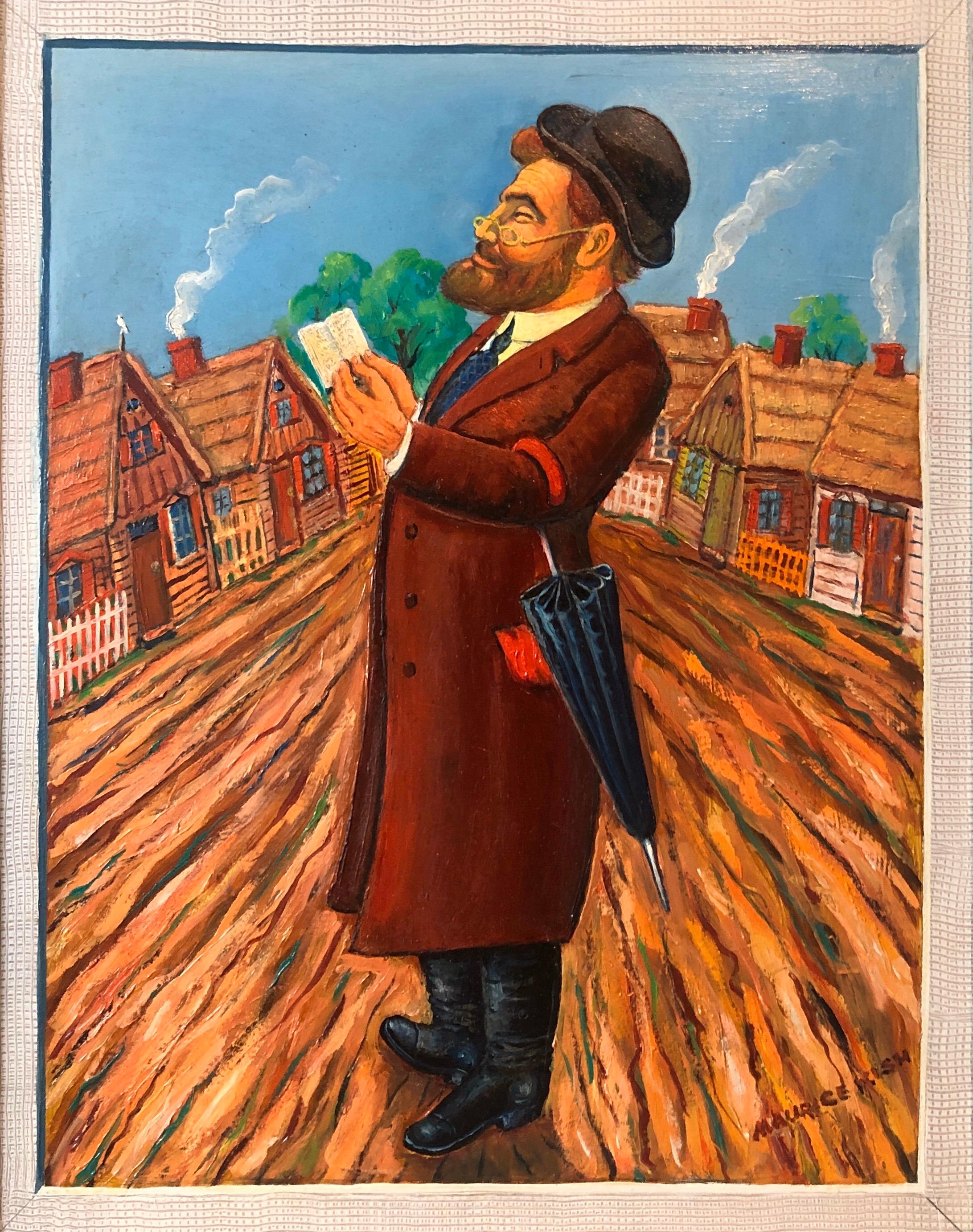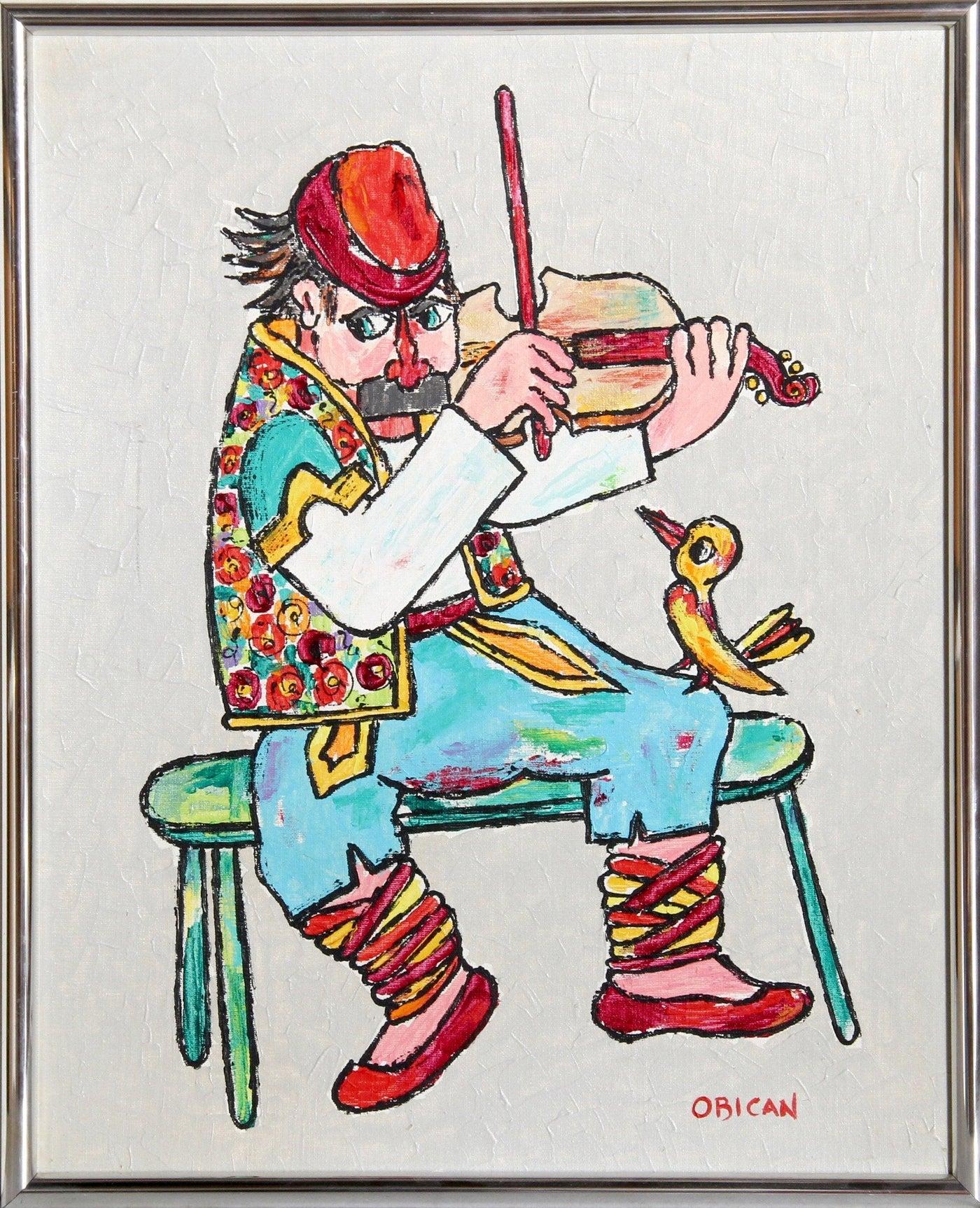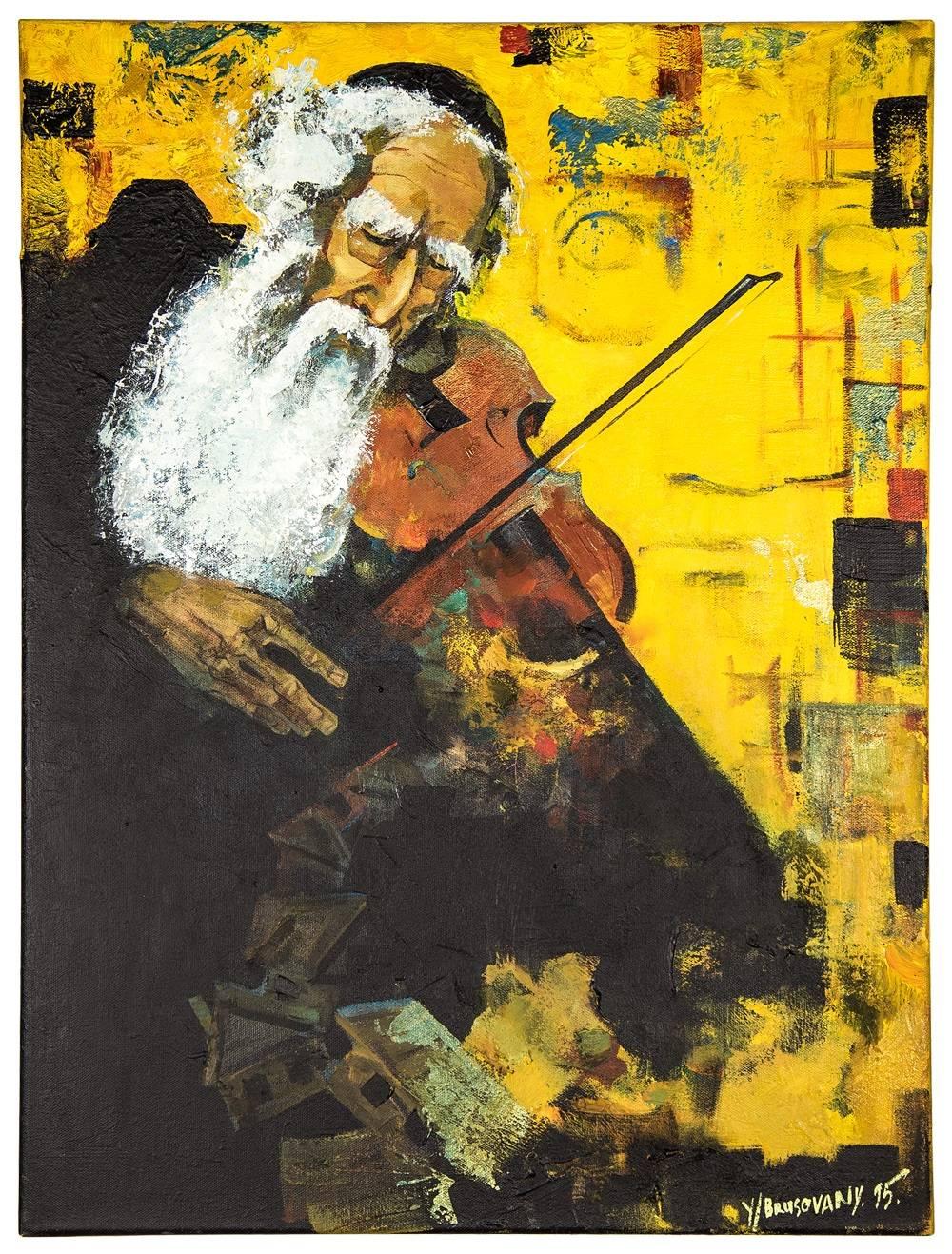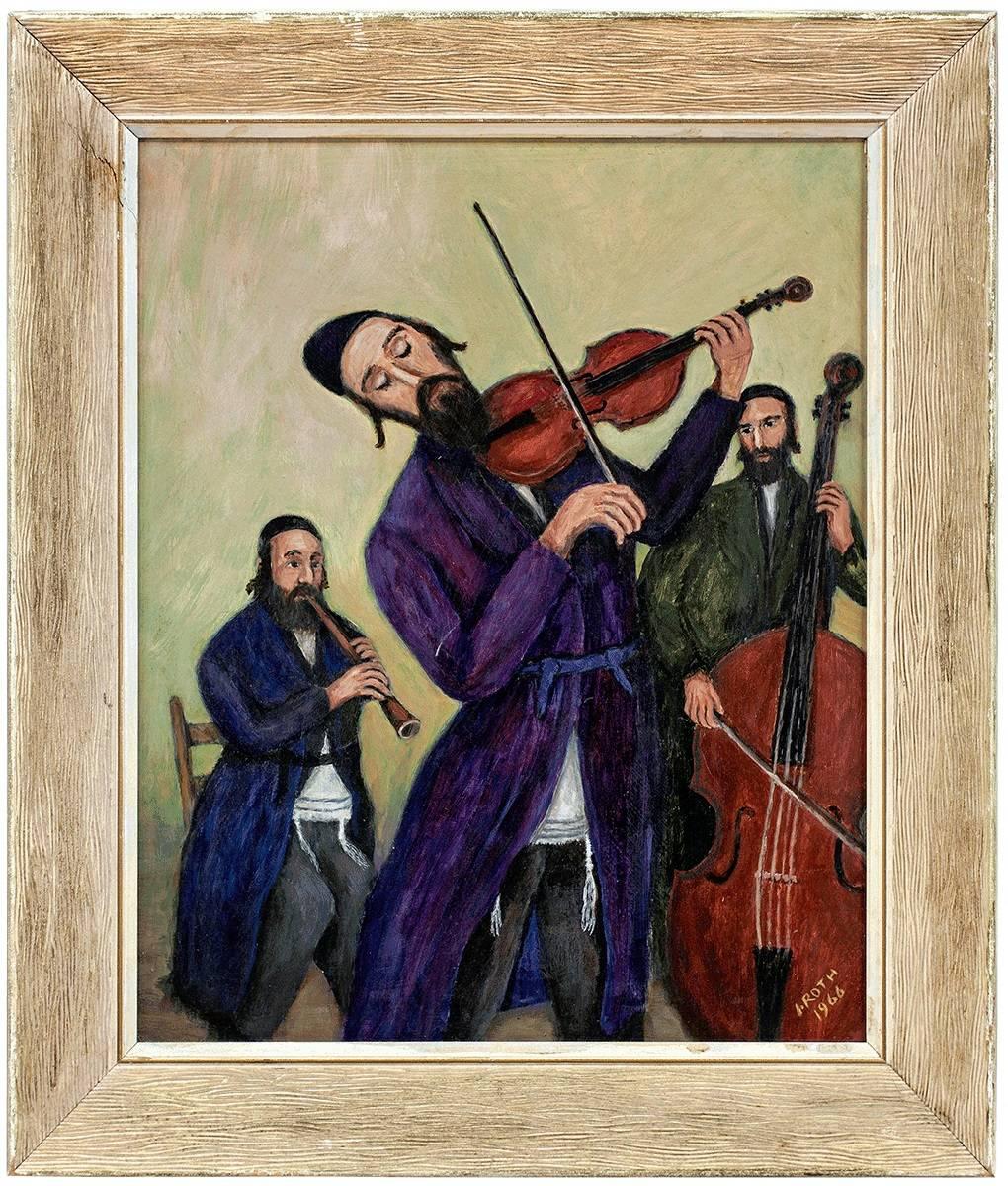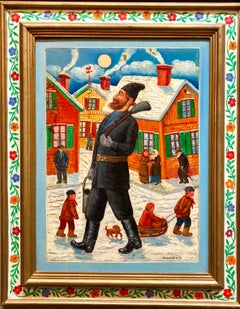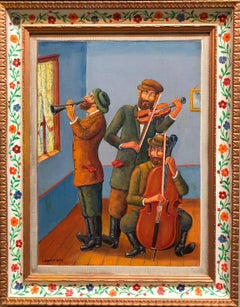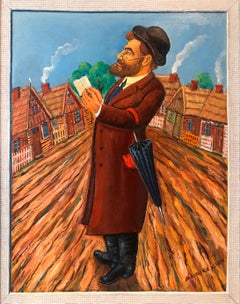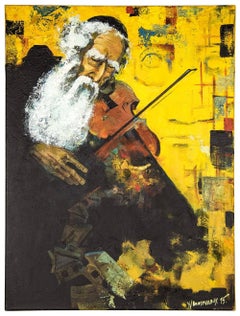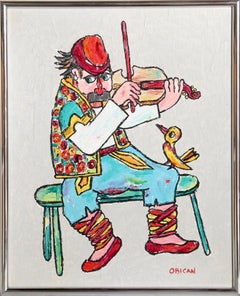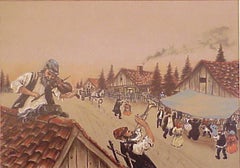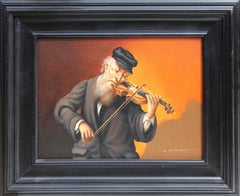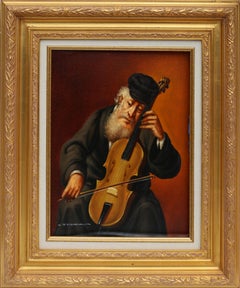Items Similar to Fiddler on the Roof Modern Judaica Shtetl Oil Painting WPA Jewish artist
Want more images or videos?
Request additional images or videos from the seller
1 of 9
Maurice KishFiddler on the Roof Modern Judaica Shtetl Oil Painting WPA Jewish artist1955
1955
$4,000
£3,036.73
€3,473.37
CA$5,588.58
A$6,215.72
CHF 3,245.66
MX$75,638.71
NOK 41,451.98
SEK 38,874.65
DKK 25,923.12
Shipping
Retrieving quote...The 1stDibs Promise:
Authenticity Guarantee,
Money-Back Guarantee,
24-Hour Cancellation
About the Item
Genre: Modern
Subject: Fiddler on the roof
Medium: Oil
Surface: Board, size includes artist decorated frame
Country: United States
The imagery of Maurice Kish (1895-1987), whether factories or carousels, reliably subverts expectations. His vision hovers just around the unraveling edge of things, where what is solid and clear becomes ambiguous. He is fascinated, often delighted, by the falling apart. This unexpected, fresh perspective results in oddly affecting pictures of a now long-gone New York.
Born Moishe in a town called Dvinsk, Russia (what is now Daugavpils, Latvia), Kish came with his family to New York when he was in his teens. The family settled in Brownsville, and for the rest of Kish’s life Brooklyn remained his home, though he moved from one neighborhood to another. He was close to his parents, who recognized his talent and supported his desire to become an artist.
Kish attended the National Academy of Design as well as Cooper Union. His fellow students included many other immigrants and children of immigrants who were particularly receptive to the Modernism coming from Europe. As his career progressed, Kish himself applied different strains of Modernism to different purposes. For him, the story was held above all else.
For years, Kish used the skills he acquired in art school to earn his living at a Manhattan glass factory where he painted floral designs on vases. During the Depression, Kish became a WPA painter in the Federal Art Project (FAP). FAP artists were given a mandate to create works that celebrated labor. The artists tended to be socially progressive, as Kish certainly was. Kish's work from this period, with its dark colors and rolling clouds, reveals the influence of Social Realists like Thomas Hart Benton. Apparent, too, is Kish's interest in the urban monumentality of Charles Sheeler. Kish's structures, however, lack Sheeler's almost dehumanized precision. Rather than the soulless, sleek machines of a typical modern urban dystopia, Kish's factories are shaggy old beasts as worn out as the laborers who troop through their doors. In End of Day's Toil, now at the Smithsonian, the viewer feels some affection for that rambly grandfather of a building all the tired small workers are leaving behind.
Much of Kish's work, for the FAP and elsewhere, undermines received truths in a similar way. Some early works with themes from Yiddish culture are overtly humorous: a painting of a big jolly wedding guest, looking invitingly over her shoulder; a big fiddler on a small roof. Later, the humor becomes more ironic and reflective. In another work, the rather imposing organ grinder of the late 1930s looms above a child, yet his intermediary the cockatoo is bright and appealing, and offers the girl a fortune with his beak. This could read as an allegory for capitalism as easily as a straightforward colorful street scene. A small painting of a snowy day in Washington Square gives a bird's eye view of people bent against the wind walking alone or in pairs. The huge triumphal arch at the middle of it has no connection to their movements or their lives. Kish makes its size and centrality a quiet joke about the futility of grandiose gestures. Like the buildings in his FAP works, the arch has a personality. It is a landmark that looks a bit lost.
A favorite location for Kish was Coney Island. For the laborers of the city, this was a place of great freedom and possibility. There were no bosses! Anyone could go to ride the rides and swim in the sea. For Kish, Coney Island, and especially Luna Park, became a place richly symbolic of workers’ rights. For the dreamlike paintings he set there, Kish looked past the Social Realists to the Expressionists. His colors are brilliant and his lines are wild. These images, joyfully unrestrained, give full voice to an anarchic vision merely hinted at in other works. If the structures of the earlier pictures came further out of the background than expected, these Coney Island structures completely take over the scene.
Kish made several variations on the theme of the carousel as a site of revolution. In the moonlight, the horses have broken from their poles and spin away from the calm center. The workers have come to manic life, have released themselves from the yoke of labor and have abandoned their master, the merry-go-round. They escape to different corners of the pleasure park, dance together and ride the ferris wheel. One horse pretends to be a ticket seller. It is another allegory, one that depicts a worker's holiday paradise in carnival fashion.
A painter who embraced ambiguity, Kish was himself a man who occupied many worlds simultaneously. Even during the period when he had shows at prestigious galleries and belonged to several artists' groups, he identified most strongly as an outsider, a Yiddischer. He wrote poetry in Yiddish throughout his life. In 1968, he published a volume of fifty years of these poems, Di Velt ist Mayn Lid (The World is My Song) in Yiddish, with no English translation, for his peers. Kish also translated English-language poetry into Yiddish and acted as a guide to help other Yiddish writers. Long after the art organizations ceased to provide meaning and fulfillment, Kish was a devoted member of the Yiddish Culture Association.
In addition to painting and poetry, Kish was a dancer who taught during the summers at various Jewish resorts in the Catskills. Small but lithe, he also spent some years as an amateur boxer. Well into his eighties, Kish was proud of the quality of his handball game.
By the 1940s, Kish’s career was going well, but his descriptive style of working began to fall out of fashion, supplanted by a more formal Abstraction. Kish was never able to support himself solely through his art, yet in the midst of all of his other activities, Kish continued to create his distinctive images of an immigrant's New York. He departed far from the mainstream, and in later years, seldom showed his work, preferring to keep it for himself (although he sometimes traded paintings for rent).
Of making art, Kish said, "It is a sacred mission to enrich, to elevate and to make our lives more complete." His works, though frequently playful, encourage a second look at ordinary things. His irreverence elevates by revealing flaws where his audience, all workers and outsiders of a kind, can get a purchase. Kish's art fondly celebrates the beauty of the irregular.
- Creator:Maurice Kish (1895-1987, American)
- Creation Year:1955
- Dimensions:Height: 20.5 in (52.07 cm)Width: 16.5 in (41.91 cm)
- Medium:
- Movement & Style:
- Period:
- Condition:minor wear.
- Gallery Location:Surfside, FL
- Reference Number:1stDibs: LU38212767742
About the Seller
4.9
Platinum Seller
Premium sellers with a 4.7+ rating and 24-hour response times
Established in 1995
1stDibs seller since 2014
1,784 sales on 1stDibs
Typical response time: <1 hour
- ShippingRetrieving quote...Shipping from: Surfside, FL
- Return Policy
Authenticity Guarantee
In the unlikely event there’s an issue with an item’s authenticity, contact us within 1 year for a full refund. DetailsMoney-Back Guarantee
If your item is not as described, is damaged in transit, or does not arrive, contact us within 7 days for a full refund. Details24-Hour Cancellation
You have a 24-hour grace period in which to reconsider your purchase, with no questions asked.Vetted Professional Sellers
Our world-class sellers must adhere to strict standards for service and quality, maintaining the integrity of our listings.Price-Match Guarantee
If you find that a seller listed the same item for a lower price elsewhere, we’ll match it.Trusted Global Delivery
Our best-in-class carrier network provides specialized shipping options worldwide, including custom delivery.More From This Seller
View AllProud Chimney Sweep Modern Judaica Shtetl Oil Painting WPA Jewish artist
By Maurice Kish
Located in Surfside, FL
Genre: Modern
Subject: Klezmer Musicians
Medium: Oil
Surface: Board, size includes artist decorated frame
Country: United States
The imagery of Maurice Kish (1895-1987), whether fa...
Category
Mid-20th Century Modern Figurative Paintings
Materials
Oil
Three Klezmer Musicians Modern Judaica Shtetl Oil Painting WPA Jewish artist
By Maurice Kish
Located in Surfside, FL
Genre: Modern
Subject: Klezmer Musicians
Medium: Oil
Surface: Board, size includes artist decorated frame without frame 16X12
Country: United States
The imagery of Maurice Kish (189...
Category
Mid-20th Century Modern Figurative Paintings
Materials
Oil
Whimsical Judaica Shtetl Shadchan Matchmaker Oil Painting WPA Jewish Folk Artist
By Maurice Kish
Located in Surfside, FL
Genre: Modern
Subject: Fiddler on the roof, Shtetl matchmaker
Medium: Oil
Surface: Board, size includes artist decorated frame
Country: United States
The imagery of Maurice Kish (18...
Category
Mid-20th Century Folk Art Figurative Paintings
Materials
Oil, Board
Post Soviet Avant Garde Judaica Rabbi Playing Violin (the Klezmer Fiddler)
By Yuri Brusovany
Located in Surfside, FL
Genre: Contemporary
Subject: People
Medium: Oil
Surface: Canvas
Dimensions: 24" x 18"
Yuri Yefimovitch Brusovany was born on November, 15th 1949 in Leningrad (St. Petersburg) Russia. His father was a Jew from Gomel. His mother descended from the prominent family of Samoiloff Actors. This family was well-known all over Russia for a long time. Since 1820 names of the actors from the Samoiloffs' Dynasty never left the theatre posters. It was the largest family tree in the history of Russian scenic art. The central figure in the dynasty was V.V. Samoiloff (1834 - 1877) lived at the same time with Feodor Dostoevsky, Karl Brullov and Leo Tolstoy. V.V. Samoiloff, P.V. Samoiloff and V.A. Michurina-Samoilova were buried at the Alexander Nevsky...
Category
1990s Expressionist Figurative Paintings
Materials
Canvas, Oil
Folk Art Naive Judaica Klezmer Hasidic Musicians
Located in Surfside, FL
Jewish Chassidic Klezmer Shtetl Musicians
Category
1960s Folk Art Figurative Paintings
Materials
Oil, Board
Dance of the In laws Wedding Scene Judaica Shtetl Oil Painting WPA Jewish Artist
By Maurice Kish
Located in Surfside, FL
Genre: Modern
Subject: Jewish Wedding Mechutanim
Medium: Oil
Surface: Board, size includes artist decorated frame
Country: United States
The imagery of Maurice Kish (1895-1987), whe...
Category
Mid-20th Century Modern Figurative Paintings
Materials
Oil
You May Also Like
Fiddler, Signed Folk Art Oil on Board by Jovan Obican
By Jovan Obican
Located in Long Island City, NY
Fiddler
Jovan Obican
French/Yugoslavian (1918–1986)
Date: circa 1980
Oil on board
Size: 16 x 20 in. (40.64 x 50.8 cm)
Frame Size: 21 x 17 inches
Category
1980s Folk Art Paintings
Materials
Oil
"Fiddler on the Roof"
Located in Fort Washington, PA
Medium: Oil on Cloth
Signature: Signed Lower Left
"Fiddler on the Roof"
Category
20th Century Figurative Paintings
Materials
Fabric, Oil
Violinist, Oil Painting by Abraham Straski
By Abraham Straski
Located in Long Island City, NY
Artist: Abraham Straski, Polish (1903 - 1987)
Title: Violinist
Year: 1958
Medium: Oil on Canvas, signed l.r.
Image Size: 12 x 15 inches
Frame Size: 20 x 22.5 inches
Category
1950s Post-War Portrait Paintings
Materials
Canvas, Oil
Jewish Man Playing Viol, Framed Oil Painting by Abraham Straski, 1952
By Abraham Straski
Located in Long Island City, NY
Jewish Man Playing Viol (3-F)
Abraham Straski, Polish (1903–1987)
Date: 1952
Oil on Canvas, signed and dated
Size: 16 x 11.5 in. (40.64 x 29.21 cm)
Frame Si...
Category
1950s Post-War Portrait Paintings
Materials
Canvas, Wood, Oil
The Violin Player Painting Outsider Folk Artist Gloria Laposka
Located in South Burlington, VT
"Violin Player" Vibrant Colored Hand Painting
A framed oil painting on canvas panel by Self Taught Outsider Surrealist Folk Artist Gloria Antoinette Laposka (1922-2015)
Said Lapo...
Category
Late 20th Century American Folk Art Outsider and Self Taught Art
Materials
Canvas, Wood
Fiddler - XI, Folk Art Ink on Paper by Ira Moskowitz
By Ira Moskowitz
Located in Long Island City, NY
Ira Moskowitz, Polish/American (1912 - 2001) - Fiddler - XI, Year: circa 1989, Medium: Ink on Paper, signed, Size: 13 in. x 10 in. (33.02 cm x 25.4 cm), Description: Playing music ...
Category
1980s Folk Art Portrait Drawings and Watercolors
Materials
Ink
More Ways To Browse
For Rent
Jewish Russian Painting
Judaica Artist
Children In The Park Painting
Jewish Mid Century Art
Man On Horse Painting
Modern Judaica Painting
Oil On Board Paintings 1940s
Girl On Horse
Vintage Spin Art
Vintage Manhattan Glass
Hart Oil Paintings
Catskills Painting
Wpa Styled Oil Paintings
Vintage Machine Oiler
Girl Horse Painting
Oil Paintings Of Jewish Man
Judaica Oil Painting
